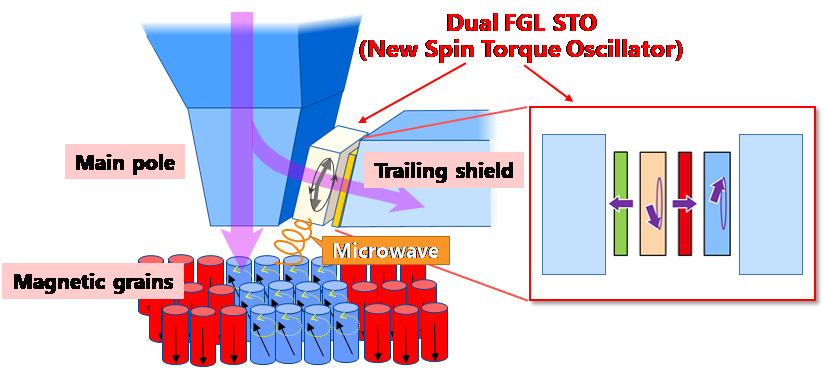A three-way collaboration between Showa Denko, TDK and Toshiba has resulted in a demonstration of MAMR recording technology showing that 30+ terabyte disk drives are possible.
Toshiba disk drives use Showa Denko platters and TDK read/write heads, and the three suppliers have been engaged in a joint effort to develop Microwave-Assisted Magnetic Recording (MAMR) technology as a way of overcoming the thermal stability limitations of current Perpendicular Magnetic Recording (PMR) technology. PMR bits become unstable as their size shrinks below the 2TB/platter areal density point. MAMR records bits in a more stable but resistant recording medium, which needs beamed microwave energy to assist the read/write heads in writing bits.
The microwaves are generated by a Spin Torque Oscillator (STO) positioned next to the write head. Toshiba is using a MAMR precursor, Flux Control MAMR (FC-MAMR), in its current MG09 and MN09 18TB drives. The STO used includes a microwave Field Generation Layer (FGL) and a Spin Injection Layer (SIL). FC-MAMR is an approach technology for full MAMR. It involves reversing the direction of the STO and so providing a 20 per cent areal density gain to PMR technology.

The next step in Toshiba’s development was Microwave Assisted Switching-Microwave Assisted Magnetic Recording (MAS-MAMR) and this appeared in December last year as a strong possibility with a Showa Denko platter development. It uses resonance-enhanced magnetic oscillations between the STO and the recording medium, which enables writing data in narrower tracks in the media. MAS-MAMR drives capacity gains higher than FC-MAMR.
Toshiba says it has invented a “bi-oscillation type spin torque oscillator device (dual FGL STO)” that irradiates microwaves with a two-layer field generator. The “dual FGL STO” generates microwaves more efficiently, with less current and on focused spots.
It has confirmed stable oscillation of STOs in new TDK recording heads. It has also confirmed the MAS-MAMR effect by combining the newly developed STOs, recording heads and media, and demonstrated an approximately 6dB improvement in recording performance with MAS-MAMR.

Toshiba says it aims to realise early commercialisation of nearline HDDs with capacities exceeding 30TB. No timescales have been provided, but we are thinking four to six years. It says it will continue to develop FC-MAMR and MAS-MAMR technologies to expand the capacity of nearline HDDs. Toshiba will also continue to develop the Thermal Assisted Magnetic Recording (TAMR or HAMR as it is generally known) technology in parallel, to meet a wide range of storage needs. This is what Western Digital is doing as well.
Competitor Seagate is focusing on HAMR, with no publicly revealed MAMR developments.
Toshiba is announcing details of its MAS-MAMR demo and technology at the international Joint MMM-INTERMAG Conference 2022, being held in New Orleans from January 10–14, 2022.








